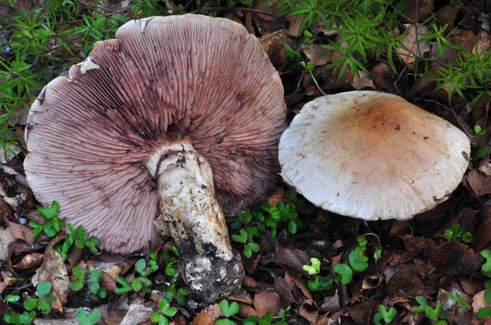 Hebeloma victoriense (Photo: N. Siegel)
Hebeloma victoriense (Photo: N. Siegel)Taxonomy
Full name: Hebeloma victoriense A.A. Holland & Pegler, Transactions of the British Mycological Society 80 (1): 157 (1983)Genus: Hebeloma
Section: Porphyrospora
Types: AUSTRALIA: Victoria: King Lake NP, Dandenong Range, Melbourne (approx. 37.5167°S, 145.3167°E, alt. approx. 600 m a.s.l.) under Eucalyptus sp., 7 May 1981, A.A. Holland, det: Holland, Pegler (AAH71581) (Holotype. herbarium acc. no. K(M)80012, HJB1000047; Isotype. herbarium acc. no. MEL 2121988, HJB1000300).
Heterotypic synonyms:
- Hebeloma subvictoriense B.J. Rees, Mycologia 105 (4): 1052 (2013)
- Hebeloma khogianum Bresinsky, Bulletin trimestriel de la Société Mycologique de France 116 (3): 219 (2000)
- arrow_drop_downarrow_drop_upEtymology
- arrow_drop_downarrow_drop_upOriginal diagnosisPileus 5-10 (-21) cm latus, convexus vel applanatus, carneo-cinnamomeus vel ochraceo-bubalinus, glaber, nitidus, mox siccus, laevis vel leviter squamulosus, ad marginem primo appendiculatus, postremo recurvatus. Lamellae sinuatae, vinaceo-bubalinae vel atrovinaceo-brunneae, ventricosae, confertae, cum tribus ordinibus lamellularum intermixtae. Stipes 5-13 x 1.5-2 cm, subbulboso-clavatus, ad basim 3.5-4.5 cm latus, solidus; albidus velbubalino-brunneus,siccus, fibrillosus. Annulus membranaceus, peronatus, Caro ad 2 cm crassa, albida, immutabilis; hyphae ornnes fibulatae; odor indistinctus. Sporae in cumulo vinaceo-brunneae, 8-10 x 4-6 (8.9±o.6 x 5.15±0.3) μm, Q= 1.74, amygdalifonnes, luteo-brunneae, crassitunicatae, subtiliter verruculosae. Basidia 3-35 x 5-8 μm, clavata, 4-sporigera. Acies lamellarum sterilis. Cheilocyst idia copiosa, 50-65 x 5-12.5 μm, versiformia, clavata vel sinuosofusiformia, interdum constricta, hyalina, tenuitunicata. Pleurocystidia nulla . Trama hyrnenophoralis regularis, hyalina . Epicutis pilei ex hyphis agglutinatis, radialibus, 3-5 μm latis, encrustatis composita.
- arrow_drop_downarrow_drop_upEnglish translationPileus 5-10 (-21) cm broad, convex or applanate, pinkish-cinnamon or ochraceous-buff, glabrous, shining, margin at first appendiculate, finally recurved. Lamellae sinuate, vinaceous-buff or dark vinaceous-brown, ventricose, crowded, with three length-ranks of lamellulae. Stipe 5-13 x 1.5-2 cm, subbulbose to clavate, 3.5-4.5 cm broad at the base, solid; whitish or buff-brown, dry, fibrillose. Annulus membranous, peronate. Context up to 2 cm thick, whitish, unchanging; hyphae all clamped; smell indistinct. Spores vinaceous-brown in mass, 8-10 x 4-6 (8.9±0.6 x 5.15±0.3) μm, Q= 1.74, amygdaliform, yellowish-brown, thick-walled, slightly roughened. Basidia 3-35 x 5-8 μm, clavate, four-spored. Lamellar edge sterile. Cheilocystidia numerous, 50-65 x 5-12.5 μm, versiform, clavate or sinuous-fusiform, at times constricted, hyaline, thin-walled. Pleurocystidia none. Hymenophoral trama regular, hyaline. Pileus epicutis composed of radial, agglutinated, encrusted hyphae, 3-5 μm wide.
References
Description
- arrow_drop_downarrow_drop_upThresholds
Description of Hebeloma victoriense based on 22 collections
- arrow_drop_downarrow_drop_upMacroscopic descriptionPileus: (50) 75–116 (140) mm diameter; shape convex, rarely umbilicate; characters remains of universal veil, occasionally squamulose; margin characters involute; viscosity tacky when moist; colour variation usually two color, occasionally unicolour; colour at centre occasionally ochraceous, clay-buff or yellowish brown.
Lamellae: attachment often emarginate, occasionally decurrent or decurrent tooth; maximum depth 6–10 mm; number of complete lamellae 100–150; presence of tears visible with naked eye; white fimbriate edge often weak or very strong.
Cortina presence: often yes, occasionally no.
Stipe: (10) 22–90 (130) x (10) 13–36 (40) {median} x (10) 13–40 (50) {basal} mm; stipe Q 0.8–6.5; base shape often bulbous, occasionally clavate or tapering, rarely cylindrical; floccosity pruinose at apex, often fibrillose or floccose, occasionally transverse; rooting often no, occasionally yes; thick rhizoids at base absent;
Context: Texture firm; stipe interior hollow; stipe flesh discolouring often no, occasionally yes; slenderness measure 0.1–5.9; smell often odourless, occasionally marzipan; taste weakly bitter or sweet where recorded.
Spore deposit colour: Not recorded.
Exsiccata characters: Not recorded.
- arrow_drop_downarrow_drop_upMicroscopic descriptionSpores: shape amygdaloid, often lacrymoid; colour in microscope often yellow or yellow brown; guttules variable. papilla no; Spore Code: (O1) O2; P0 P1 (P2); D1 D2.
Basidia: (17) 18–30 x (4) 5–8 μm; ave. Q 2.9–4.1; spore arrangement Not recorded;
Cheilocystidia: main shape capitate-stipitate, clavate-stipitate or spathulate-stipitate; special features observed often sinuate, occasionally rostrate, many collapsed in exsiccata, mucronate or septa; cheilocystidia ratios: A/M = 1.93–2.32; A/B = 2.14–2.65; B/M = 0.88–0.98.
Pleurocystidia: often none seen, occasionally seen.
Ixocutis: epicutis thickness (measured from exsiccata) not recorded; ixocutis hyphae width not recorded; ixocutis hyphae encrustation Not recorded; shape of trama elements beneath subcutis Not recorded.
Caulocystidia: Similar to cheilocystidia but larger.
- arrow_drop_downarrow_drop_upSpore measurements
- arrow_drop_downarrow_drop_upCheilocystidia measurements
- arrow_drop_downarrow_drop_upHabitat and distributionHebeloma victoriense's preferred habitat appears to be woodland with soil or boggy soil. Where only one possible associate was recorded, the most commonly recorded associate was Eucalyptus (53.9%) but Nothofagus (30.8%), Myrtaceae (7.7%) and Melaleuca (7.7%) were also recorded. In these cases the most commonly recorded families were Myrtaceae (57.1%) and Nothofagaceae (42.9%). Overall the most commonly recorded families are Myrtaceae (62.5%) and Nothofagaceae (50.0%) The growth habit of our collections was often scattered or caespitose.
According to our current collections, the species is predominantly found in Australasia (95.5%) but also found in Pacific (4.5%). On these continents, collections have been found only in the temperate broadleaf & mixed forests WWF biome The World Wildlife Fund (WWF) have divided the world into 867 terrestrial ecoregions. The ecoregion here is estimated by mapping from the GPS coordinates of the collection using data made available by Dinerstein et al (2017). Use this webtool to explore the ecoregions visually or see a full list of current ecoregions on Wikipedia. (Eastern Australian temperate forests (35.0%) and Tasmanian temperate rain forests (15.0%) ecoregions). From collector information, it appears collections have been found in the 1.4 Forest – Temperate (55.6%), 1.1 Forest – Boreal (22.2%), 3.4 Shrubland –Temperate (11.1%) and 1.5 Forest – Subtropical/tropical dry (11.1%) IUCN habitats We map from the collector's description of the habitat to the International Union for Conservation of Nature (IUCN)'s definition using a standardised set of rules. Please see this page for a full list of IUCN habitats..
Within Australasia we have records from Australia (Victoria, Tasmania and New South Wales) and New Zealand (New Zealand).
Within Pacific all our records are from Southwestern Pacific (New Caledonia).
Geographic distribution
Phenology
- arrow_drop_downarrow_drop_upAdditional cited collections